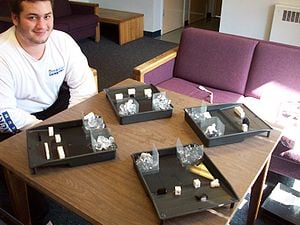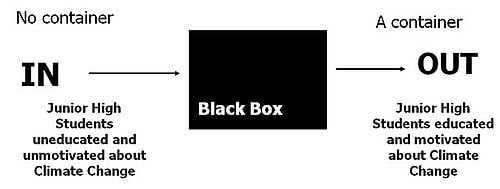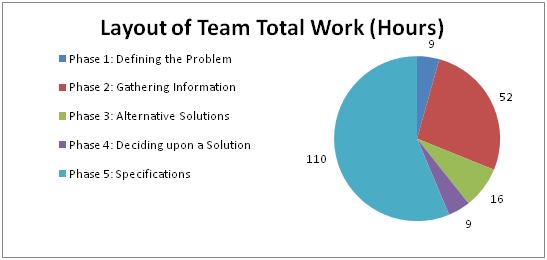
The Seas of Change project models the process of global climate change melting polar ice caps and raising sea levels that will eventually cover cities and destroy polar bear habitat.
Background[edit | edit source]
The Spring 2010 Engineering 215 Introduction to Design class, as part of the Environmental Resources Engineering program located at Cal Poly Humboldt and taught by Lonny Grafman, took upon a project issued by the Redwood Coast Energy Authority. this projects purpose is for engineering students to create a reusable model that can be used by teachers to teach students about either climate change, energy conservation, or renewable energy. The Seas of Change project was created by Alex Albin, Chris Coutinho, and Britlandt Abney to educate middle school students about climate change.
Objective[edit | edit source]

The objective of our project is to create a model that educates a fifth through eighth grade students about the effects of and possible solutions to climate change. Both the problem of climate change and the research we conducted at a local school aided in the construction of this model. Following the use of this project, the children will be more aware of the problem of climate change and be more motivated to make positive changes in the world around them.
Criteria[edit | edit source]
The target audience for this project is junior high students. Our mission was to educate them about the way climate change is affecting the planet and life on it while making the information interactive and entertaining. This problem analysis is composed of specifications, criteria, and constraints that were addressed when choosing alternative solutions. After researching information ranging from causes of climate change to middle school psychology, we used the knowledge gained along with information from the client, and compiled a list of criteria and constraints for our model. These lists helped analyze and better understand the problem and come up with a more productive and efficient solution.
Table 1: Criteria in choosing the project[edit | edit source]
| Criteria | Weight | Description |
|---|---|---|
| Safety | 10 | Doesn't harm users or viewers |
| Durability | 9 | Must last one year with weekly use |
| Educational Value | 9 | Gives students as much education as possible while meeting California educational standards |
| Ease of use | 8 | Less than 15-20 minute set up time per use |
| Ease of maintenance | 8 | Less than 15-20 minute clean up time per use |
| Level of Fun | 7 | As fun as possible for age group |
| Age Appropriate | 7 | Targets middle school children |
| Cost | 5 | As cheap as possible within our $325 budget ($75 per team member and $100 from the RCEA) |
Design Solution[edit | edit source]
Our most successful solution according to the assigned criteria ended up being "The Seas of Change". This solution involved ice melting in a water container and overflowing a model town just next to the original sea level. As the ice melts in the warmed water the level would rise and destroy/flood the model town along the shoreline created. This idea has been combined with our Polar Bear idea. This solution consisted of a model polar bear drowning in a sea as the ice cube he stands upon melts in the warmed water. Both solutions have warm water as well as ice cubes so the combination of the two solutions was a relatively easy one.
The model has four trays so that more students may be involved in the project. A rotating heat lamp in the middle will represent the sun and provide some heat for the four trays surrounding it. Each tray will have trapped sections of crushed ice in the corners representing the globe's polar ice caps along with a model town along an elevated shore. In addition a polar bear will be sitting on top of one of the ice caps in each tray. Warm water will be poured into each tray up to the shore level to represent normal sea levels. As the warm water melts the ice caps the water level will rise. This will result in the polar bear being submersed in the water as well as the coastal town being flooded. The design will metaphorically yet accurately represent several of the damaging effects of global warming, including rising seas, animal migration habits being altered, and warming sea waters.
Design Costs[edit | edit source]
Materials and construction costs for the Seas of Change were not big factors in the project. The project's budget must have been kept under $325, which was met successfully, depicted in Table 2.

Table 2: Spending sheet[edit | edit source]
| Item | Cost |
|---|---|
| Gas | $ 44.58 |
| Polar Bear | $ 3.87 |
| Plastic Paint Trays | $ 8.68 |
| Metal Screen | $ 6.50 |
| Popsicle sticks | $ 0.40 |
| Spray Paint | $ 21.36 |
| Nippy Cutter | $ 6.53 |
| Food for thought | $ 6.03 |
| Pitcher | $ 5.99 |
| Epoxy | $ 21.94 |
The entire model with four separate trays cost the group $120.97
The team's estimated work in hours for this project is depicted in Figure 2. As of May 5, the total time spend by the Three Mengineers on the Seas of Change is 195 hours. This computes to a little over 65 hours per member.
Testing Results[edit | edit source]
The design was tested at Fortuna High School on Monday April 26th, as well as Wednesday May 5th for the purposes of creating a video for this project. In both occasions the trays were set up with ice in the cages and water filled up to the designated sand level now marked by spray painted grip tape (to simulate the sand of a beach). In addition, ice was placed into the water as well to represent floating ice bergs. After the water had been added to each of the four trays, time was given for the ice to melt. The kids breathed on the ice during the waiting period to speed along the process and metaphorically represent the anthropogenic causes of climate change. The desired results were that the water level would rise to a point that it covered the town.
The two tests were given somewhere between eight and fifteen minutes to let the ice melt and the students fill out the first section of the worksheet. After each allotted amount of time, the results turned out exactly as desired. The water level raised a significant amount dragging several model buildings out to sea and leaving the others partially to fully submerge. The polar bear was also submerged in 3 out of 4 trays during the Fortuna High testing which was also a desired result. Few issues occurred; however among these were students not filling the water level to the designated beach line and students placing too much ice into the cages. All in all however the results turned out very successfully and needed few modifications post High School testing.
Instructions for Implementation[edit | edit source]
- Separate the students into four even groups and have a member from each group take the following materials to their group's desk:
- 1 coastal model tray
- 1 polar bear
- A set of Lego™ building pieces (marked to accompany separate trays)
- 2 cups of ice
- Place Lego buildings in marked areas on model shoreline
- Using the water jug, fill each tray with water up the edge of the model shoreline.
- Place ice in caged areas (Do not top off the cages, to prevent spillage).
- Have students fill out section one on the worksheet as the ice begins to melt.
- As the students fill out section one of the questionnaire, have a student breathe on the ice at a reasonable pace, to speed up the melting process.
- As soon as the students are done with section one, have them observe the trays.
- After observing the trays, have the students answer the remaining questions on the worksheet.
- Discuss the questions with the students.
- Carefully clean up and place the pieces back in the box as neat as or neater than originally found.